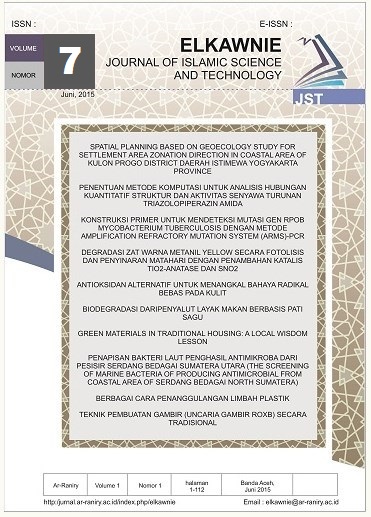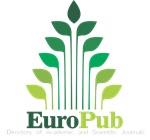Isolation And Identification of Bacteria In The Composting Process of Red Algae (Glacilaria sp) With The Addition of Cow Manure And Waste Household
DOI:
https://doi.org/10.22373/ekw.v7i2.22536Keywords:
Isolation, Identification, CompostingAbstract
Abstract: Bacterial isolation research has been conducted from composting Glacilaria sp with the addition of cow dung and household waste. Glacilaria sp samples were taken from Gampoeng Neheun Pond, Mesjid Raya district, Aceh Besar. The process of composting Glacilaria sp with the addition of other materials is done with a ratio of 2:1, the composting time lasts for 20 days. Leachate sampling is carried out on days 0; 4; 8; 12; 16; and 20 as much as 10 ml. PH, color and smell measurements of the sample are performed on each leachate sampling. The observations obtained 39 Gram-negative isolates and 40 Gram-positive isolates. With morphological forms of cells namely Coccus, Bacill, Diplococcus, Streptoccus, Streptobacillus and Staphylococcus. The bacteria are most commonly found in composting household waste.
Abstrak: Telah dilakukan penelitian isolasi bakteri dari pengomposan Glacilaria sp, dengan penambahan kotoran sapi dan limbah rumah tangga. Sampel Glacilaria sp berasal dari tambak Gampoeng Neheun, Kecamatan Masjid Raya Aceh Besar. Proses pengomposan Glacilaria sp dengan penambahan bahan lain dilakukan dengan perbandingan 2:1, waktu pengomposan berlangsung selama 20 hari. Pengambilan sampel lindi dilakukan pada hari ke 0, 4, 8, 12, 16, dan 20 sebanyak 10 ml. Dilakukan pengukuran pH, warna dan bau sampel pada setiap pengambilan sampel lindi. Hasil pengamatan diperoleh 39 isolat Gram negatif dan 40 isolat Gram positif. Dengan bentuk morfologi sel yaitu Coccus, Bacill, Diplococcus, Streptoccus, Streptobacillus dan Staphylococcus. Bakteri yang paling banyak ditemukan pada pengomposan limbah rumah tangga
References
Adityawarman, A.C, Salundik, & Lucia, C. (2015). Pengolahan Limbah Ternak Sapi Secara Sederhana di desa Patalassang Kabupaten Sinjai Sulawesi Selatan. J. Ilmu Produksi dan Teknologi Hasil Perternakan, 3(3), 171-177.
Agus, C., Eny, F., Dewi, W., & Benito, H. P. (2014). Peran Mikroba Starter Dalam Dekomposisi Kotoran Ternak Dan Perbaikan Kualitas Pupuk Kandang. Jurnal Manusia dan Lingkungan, 21(2), 179-187.
Basmal. J., Hermana, I., & Sardino. (2016). Pemanfaatan Tepung Ampas Dari Ekstraksi Agar Untuk Bahan Pupuk Tanaman. J. PB Kelautan dan Perikanan, 11(2),195-212.
Chinakwe, E. C., Ibekwe, V. I., Ofoh, M. C., Nwogwugwu, N. U., Adeleye, S. A., , Chinakwe, P. O., Nwachukwu, D. I., & Lhejirika, C. E. (2019). Effect of Temperature Changes on the Bacterial and Fungal Succession Patterns during Composting of Some Organic Wastes in Greenhouse. Journal of Advances in Microbiology, 15(1), 1-10. Article No. JAMB.47197. ISSN: 2456-7116.
Ginting. E. K., Liviani R., Letha, L. W., & Stenly W. (2019). Isolasi Bakteri Simbion Alga Merah Dari Perairan Tongkeina Sulawesi Utara. Jurnal Ilmiah Planax, 7(2). 394-400. ISSN 2302-3589.
Gultom, S. S. (2019). Isolasi dan Identifikasi Bakteri Penghasil Biosurfaktan Pada Kolam Tanah Gathering Station-Eor Plant di PT. Bumi Siak Pusako-Pertamina Hulu, Provinsi Riau. Ayan, 8(5), 55.
Kaburuan, R., Hapsoh, & Gusmawartati. (2014). Isolasi Dan Karakterisasi Bakteri Penambat Nitrogen Simbiotik Tanah Gambut Cagar Biosfer Giam Siak kecil Bukit Batu. Jurnal Agroteknologi, 5(1).
Lina, A.W., Harsuko, R., Tiwi, N. U., & Nurdin, H. (2019). Model Efektifitas Komunikasi Terhadap Kinerja Pengolahan Rumput Laut. Prosiding Seminar Nasional Perikanan dan Kelautan VIII. Fakultas Perikanan dan Ilmu Kelautan, Universitas Brawijaya. ISBN :978-602-72784-3-1.
Loppies, J.E., & Yumas, M. (2017). Pemanfaatan Limbah Cair Industri Rumput Laut Sebagai Pupuk Cair Organik Untuk Tanaman Pertanian. Jurnal Industri Hasil Perkebunan, 12(2), 66-75.
Michalak, I., Tuhy L., & Chojnacka K., (2016). Co-Composting of Algae and Effect of the Compost on Germination and Growth of Lepidium sativum. Pol. J. Environ. Stud. 25(3), 1107-1115. DOI: 10.15244/pjoes/61795.
Meze, M. G., Didik, H., Wiwiek, T., Suwarno., Agnes, T. S. E., & Rahaju, E. (2020). Deteksi molekuler Gen Penyandi Protein Virb 11 pada Brucella abortus Isolat Lokal Asal Pinang, NTT dan Strain Vaksin. J Veteriner, 21(4), 502-511. DOI: 10.19087/jveteriner.2020.21.4.502.
Palaniveloo, K., Amran, M. A., Norhashim, N. A., Mohamad-Fauzi, N., Peng-Hui, F., Hui-Wen, L., ... & Razak, S. A. (2020). Food Waste Composting and Microbial Community Structure Profiling. Processes, 8(6), 723.
Pal, P., Khatun N., & Banerjee S. K., (2017). Assessment of Microbes in Liquid Tea Compost: A Qualitative Screening. Int. J. Pure App. Biosci. 5(5): 1128-1137. DOI: http://dx.doi.org/10.18782/2320-7051.5824.
Partanen, P., Hultman, J., Paulin, L., Auvinen, P., & Romantschuk, M. (2010). Bacterial diversity at different stages of the composting process. BMC Microbiology, 10(1), 1-11.
Pratiwi, I. G. A. P., Atmaja, I. W. D., & Soniari, N. N. (2013). Analisis Kualitas Kompos Limbah Persawahan Dengan Mol Sebagai Dekomposer. Jurnal Online Agroekoteknologi Tropika, 2(4), 2301-6515.
Rahmadian, C. A., Ismail, I., Abrar, M., Erina, E., Rastina, R., & Fahrimal, Y. (2018). Isolasi dan Identifikasi Bakteri Pseudomonas sp Pada Ikan Asin Di Tempat Pelelangan Ikan Labuhan Haji Aceh Selatan. Jurnal Ilmiah Mahasiswa Veteriner, 2(4), 493-502.
Suwatanti, E. P. S., & Widiyaningrum, P. (2017). Pemanfaatan MOL limbah sayur pada proses pembuatan kompos. Indonesian Journal of Mathematics and Natural Sciences, 40(1), 1-6.
Syabaniar, L., Erina, E., & Sayuti, A. (2017). Isolasi dan Identifikasi Bakteri Asam laktat (BAL) Genus Lactobacillus Dari Feses Orangutan Sumatera (Pongo abelii) di Kebun Binatang Kasang Kulim Bangkinang Riau. Jurnal Ilmiah Mahasiswa Veteriner, 1(3), 351-359.
Vishan, I., Sivaprakasam, S., & Kalamdhad, A. (2017). Isolation and identification of bacteria from rotary drum compost of water hyacinth. International Journal of Recycling of Organic Waste in Agriculture, 6, 245-253.
Wahyuni, M. R., Sayuti, A., Abrar, M., Erina, E., Hasan, M., & Zainuddin, Z. (2018). Isolasi Dan Identifikasi Bakteri Enterik Patogen Pada Badak Sumatera (Dicerorhinus sumatrensis) Di Suaka Rhino Sumatra (SRS), Taman Nasional Way Kambas (TNWK), Lampung. Jimvet, 2(134), 474-487.
Downloads
Published
Issue
Section
License
Proposed Policy for Journals That Offer Open Access Authors who publish with the Elkawnie journal agree to the following terms:
a. Authors retain copyright and grant the journal right of first publication with the work simultaneously licensed under a Creative Commons Attribution License that allows others to share the work with an acknowledgement of the work's authorship and initial publication in this journal.
b. Authors are able to enter into separate, additional contractual arrangements for the non-exclusive distribution of the journal's published version of the work (e.g., post it to an institutional repository or publish it in a book), with an acknowledgement of its initial publication in this journal.
c. Authors are permitted and encouraged to post their work online (e.g., in institutional repositories or on their website) prior to and during the submission process, as it can lead to productive exchanges, as well as earlier and greater citation of published work (see The Effect of Open Access).

























